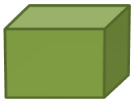
In order to calculate density, you have to know two measurements: the mass and the volume of the object.
To determine the mass of an object, you use a triple beam or electronic balance. Mass is expressed in grams.
If the object is a regular shaped object, such as a cube, you can determine the volume mathematically using the formula for volume. The formula for volume of a rectangular prism or cube is

Volume = B × h (B = area of the base), or Volume = length × width × height
The unit for volume is always expressed as units cubed. For example, cm3.
![]() Let’s practice. Determine the volume of the objects below.
Let’s practice. Determine the volume of the objects below.
What if the object is irregular in shape, such the crown Academies tested, or a rock? How do you determine the volume? You cannot determine the volume of an irregular shaped object using a mathematical formula. To determine the volume of an irregular shaped object, we must measure the fluid displaced using a graduated cylinder and water.
Let’s practice measuring displacement.
![]()
Since the density formula is mass ÷ volume, the unit for density is grams per cubic centimeter, or g/cm3.
If we have a table of known densities, we can identify the type of material that makes up the sample. Use the table below to determine the material that makes up the sample.
Material |
Density (g/cm3) |
Charcoal |
.2 |
Wood |
.9 |
Brick |
2.4 |
Iron |
7.8 |
Nickel |
8.8 |
Gold |
19.3 |
What type of material was the sample?